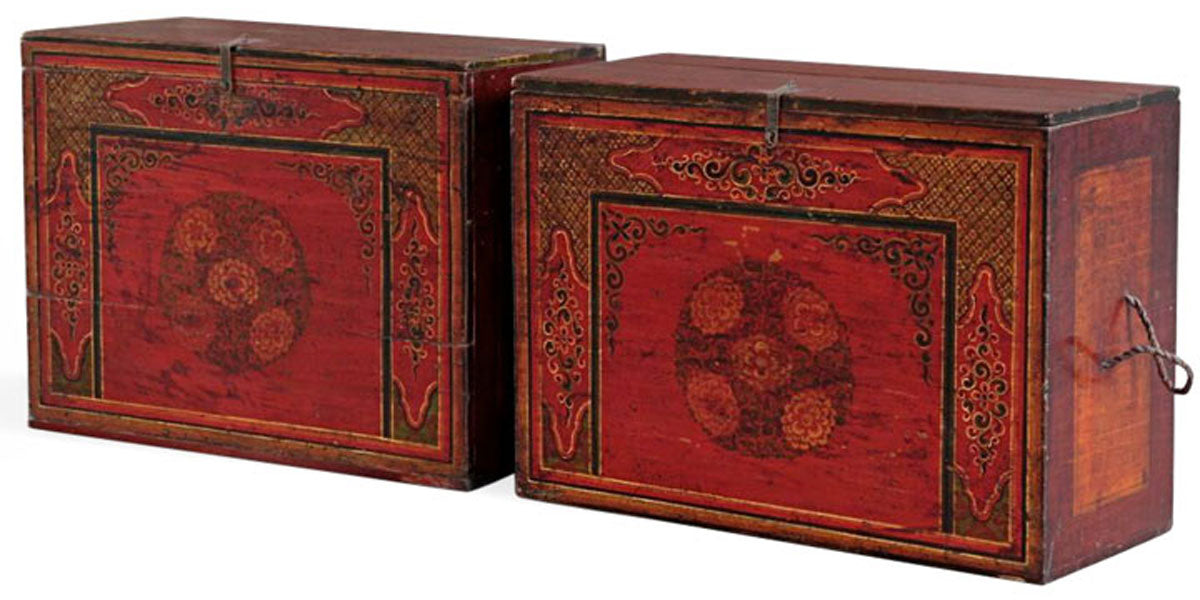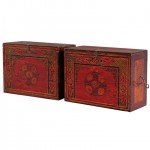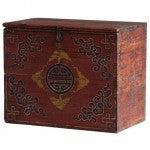
Some rare Tibetan and Mongolian Furniture on our next shipment of Chinese antiques
Each time I go to China to source antiques I find that furniture from particular regions and certain styles are becoming less and less prevalent, and the price of the these pieces is going up and up as they become more difficult to find. For example, good quality painted armoires and cabinets from Shanxi province in central China – ones with their original finish and paintings – are far harder to come by these days, whereas ten or fifteen years ago there seemed to be a ready supply. There are still warehouses that have plenty of furniture from Shanxi available, but this now tends to be refinished or touched up in some way, or often even reproduction furniture in the same style. As a result when I do find a truly authentic piece the price is usually double or even triple what it would have been when I first started in this business over ten years ago.
Chief amongst these increasingly rare pieces is furniture from Tibet and, to a slightly lesser extent, Mongolia. Part of the reason for this is that fewer pieces were produced in these parts of the world as there was less demand for furniture amongst the local nomadic population. Unlike furniture from Shanxi or other areas where tastes were more refined, the pieces that were made were quite crude – produced from cheaper materials and without the advanced joinery or lacquering techniques that helped prolong the life of cabinets and chests from central and eastern China. In short these pieces were not built to last and so a style that was already limited in number quickly fell into disuse, disrepair or destruction.
There is still Tibetan furniture available in China, indeed I have visited one or two suppliers that entirely specialise in this style. However, despite what they may try to tell you, their selection nowadays is made up almost entirely of reproduction furniture, with perhaps a few pieces being old but completely repainted.
| Pair of Tibetan Chests | Mongolian Painted Trunk | Tibetan Painted Box | Mongolian Painted Sideboard |
I was therefore very pleased to be able to source a few genuinely old Tibetan and Mongolian trunks with their original finish on my last visit to Beijing in September. These are now up on our website and will be shipping in the next week or so with our latest container of Chinese antiques, arriving in the UK around the end of December. They were held for many years by Mr Zhu, one of our main suppliers in Beijing, and were items that I had seen and admired on previous visits but which at the time did not make sense to ship without a buyer in mind. With Mr Zhu looking to clear some of his older stock including even some of the rarer pieces, the opportunity to buy these this time around was too much to resist.
Both Tibetan and Mongolian furniture is quite rudimentary in style, but brightly painted with vivid colours. In these regions there was no real consumer class as there was in Beijing or other great cities like Xian, Pingyao or Tianjin. Furniture was therefore made to be serviceable, basic in design and construction compared to the fine workmanship and joinery that developed further east. In Tibet most of this furniture was made by and for the monks, with the cabinets and trunks that were needed often produced by unskilled apprentices. The material used was normally pine, which was readily available, rather than the more attractive elm or walnut that could be found elsewhere.
Perhaps to make up for their quite crude design and construction, trunks and chests would be brightly decorated with distinctive patterns using natural pigments. The decoration normally showed flowers, sometimes birds and animals in the case of Mongolian pieces, or religious figures and artefacts. In the case of Tibetan furniture the colours used were normally vivid yellows, greens, reds, blues and blacks. Mongolian furniture tended to show a less expansive palette, with yellow, green and red being the main three colours used.
The blanket chests and trunks we are shipping this time are great examples of this type of furniture and we are unlikely to be able to find anything similar in the future – particularly in the case of the Tibetan chests. Full of character, these are very much collection pieces and ones that are only likely to increase in value over the coming years.









Leave a comment